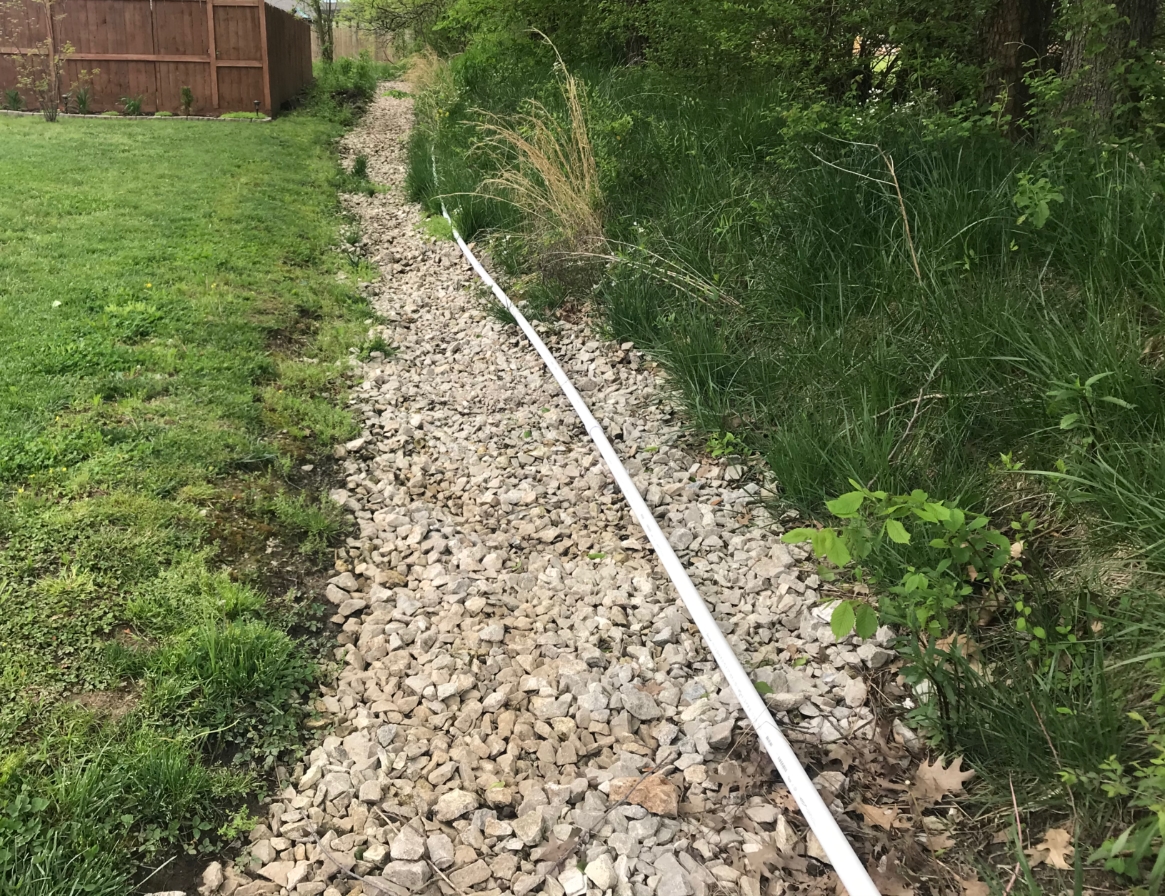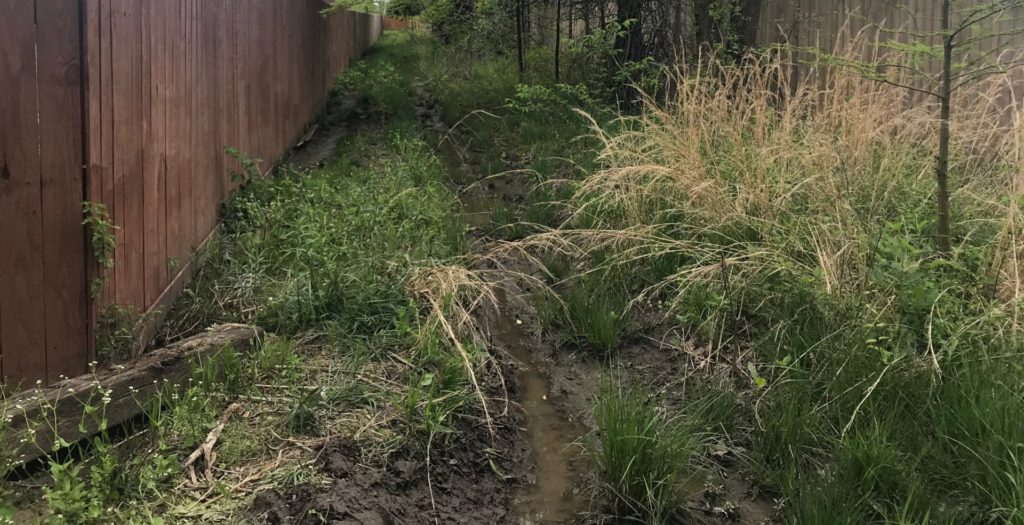A Homeowners Guide to Landscape Drainage Swales

Posted on April 25, 2022 by Jeremiah Sooter
The amount of readily available information on the internet today can make finding the correct drainage solutions for your home or business downright daunting, if not exhausting. Whether you live or work in the four-state region, you know that drainage can be a real challenge.
Whether you’re a property owner, a farmer, a rancher, or a city manager, you’ve probably had your fair share of challenges with the hydrologic process. The basic movement of water above and below the ground.
Thanks to human observation and record-keeping, we have learned how swales function and operate inside local and regional watersheds. Through that knowledge, hydrologists, landscapers, stormwater managers, and drainage experts can easily replicate the natural function of a drainage swale to move water along in a productive manner.
Functioning Landscape Swales

Since drainage professionals can duplicate the hydrologic cycle around homes, businesses, across cities, and inside communities, the challenge is deciding what function the swale will serve.
The most important aspect of building swales as a stormwater control measure is the linear drainage across a landscape. In addition, there are three main types of swales, each with a distinct drainage responsibility.
- Grass Swales
- Wet Swales
- Bioswales
But before jumping into the various types of swales, let’s define a swale in the simplest terms so there’s no confusion moving forward. A swale is not to be confused with a drainage ditch.
Instead, a swale only drops four to 12 inches below an upslope toe. The grade should stay within 0.5 percent to 1 percent of the natural slope of the surrounding terrain. There is a specific responsibility to get water moving through a groundwater system at each level or stage in a swale.
A Vegetative Swale
A common problem with swales isn’t what a swale does but the number of phrases to describe one type of swale. For example, a vegetative swale, sometimes referenced as a grassed swale, vegetated roadside swale, grassy median, dry swale, or infiltration-swale trench.
That is a lot to absorb for something as simple as a vegetative swale, which is no more than a swale that contains vegetation. Generally, water-friendly plants or grasses line the swale, specifically a vegetative swale.
The idea of swales is specific to moving water from a torrential downpour or spring runoff. Hence, the phrase dry swale since a swale is not full of water at all times.
The vegetative swale is highly popular for its biodiverse function in pollutant removal, erosion control, and helping to mitigate floodwaters. In addition, swales of this type are common throughout the United States. Along roadways and residential areas for city infrastructure on stormwater management.
Rain Gardens
Worthy of a notable mention are rain gardens. These should not be confused with swales. Instead, it’s best to think of rain gardens as a function of a swale. A rain garden falls at an endpoint, near a berm or a check dam.
The purpose of a rain garden is the final destination for channeled water, in some cases referred to as an infiltration swale. Any water not absorbed into the ground passing through a swale will have a catchment. That is a rain garden, a microclimate that cultivates a biodiverse habitat of water-friendly plants for birds and pollinators.
Wet Swales
The phrase, wet swale, is also a popularized term that replaces planted swale, vegetated swale, grass swale, or even a wetland swale. But distinctly different from the previously covered vegetative swales since a wet swale holds moisture in a constant state.
These swales are easily identifiable from the thick abundant plant life that thrive in aquatic outdoor spaces, like wetlands. The hydraulic movement is slower, leading to a more significant bulk of sediment with higher nutrient-rich loads and less oxygen in the soil.
The Bioswale
A bioswale is artificial by design to promote both infiltration and filtration using an engineered soil mix and drainage media textiles with a perforated drainage pipe, much like the French drain design.
Swales by Design
By design, the mechanics of swales as filtration systems work to remove pollutants naturally. A process that separates sediment and pollutants through chemical and mechanical systems as water moves through the swale.
No matter the function of a swale, it is primarily designed to allow surface runoff to separate material using staged filtration. For instance, a naturally occurring first step in a swale allows heavier and larger particulate to sink to the bottom first. That way, surface water can then dissolve minerals easier and begin to percolate into the ground, recharging the natural groundwater supply.
At the final stage, biologics, like algae, plants, and microorganisms, begin removing organic and inorganic material through roots for consumption, known formerly as am uptake process. If the soil has lower percolation, a swale is not a suitable drainage solution.
Marking Off A Swale
Before you start digging around, you need to think about talking with a drainage expert. They can help you determine if a swale is right for your drainage needs and help determine how to best design the swales, so you gain all the benefits.
- Removing Pollutants
- Mitigating Runoff
- Easy Maintenance
Shaping the Swale
It is easiest to begin not by tilling but by mounding. After laying the soil, dig a shallow well atop the mound. Then, start layering on an organic-rich Earth composed of composted leaves and woods. The water that percolates through it will pass through this nutrient-rich layer first.
The width and depth of the swale should be approximately three times as wide as its depth. For example, if a swale is no deeper than 12 inches, its width should be no wider than 36 inches or three feet wide. Likewise, if the minimum depth of a swale is no more than four inches, its minimum width requirement is 12 inches or 1 foot.
Plants for the Swale
For some people, selecting the plants and caring for them afterward is the best part of having a swale in their yard. There are many good plant options for swales, but you and your drainage expert must grasp your desires.
Swales commonly lined with grasses can thrive in periods of heavy saturation and withstand long periods of drought. Here in the four-state region of southwest Missouri, you’re better off introducing plants and perennial grasses with deep root systems.
Invite A Local Drainage Expert to Your Swale Party
Digging and moving dirt is heavy work, so why not call a local drainage expert to help with the heavy load. They are also qualified to assist with designing and installing the swale that follows the natural contours on your property or around your home.
The team at Ground Up Services has the heavy equipment to expedite the installation of your swale. Summer is nearly upon us, be sure to reach out to Ground Up Services today to schedule your free onsite visit. There’s no better time than right now to get those swale projects done in time for your Memorial Day cookoff.